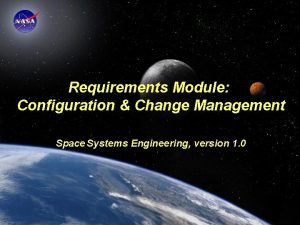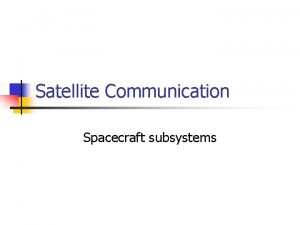SS ISTP spacecraft show direct penetration of solar


- Slides: 2

SS ISTP spacecraft show direct penetration of solar wind particles into magnetosphere It is known that energy, momentum, and mass pass from the solar wind into the magnetosphere Advanced instrumentation on POLAR and ACE use ionized ions to directly track particles (like dye in a flow of water) MEASUREMENTS: • Ace SWICS, outside the magnetosphere, measured the variable charge state of iron at solar wind energies (ke. V). • POLAR CAMMICE, moving in and out of the cusp, measured the charge state at accelerated energies (tens of ke. V). OBSERVATIONS: When POLAR was in the cusp (tan intervals): • And the interplanetary magnetic field had a southward component (Bz south), there was good agreement in the variation of the charge state (right two tan intervals). • And Bz was north – delayed agreement (second tan interval) INTERPRETATION: • Bz south allows direct entry of solar wind into the cusp. • Bz north causes considerable delay in entry. Composition of Iron in the May 2, 1998 CME (red line) was highly variable yielding an easily recognizable pattern in the Earth’s Magnetosphere (+ marks). IMPLICATIONS: Specific constraints on models of particle transport and acceleration through magnetosheath and magnetopause. Space Science MO&DA Programs - February 2000 - Page 1

SS POLAR spacecraft detects new species of aurora in response to interplanetary shock MEASUREMENTS: POLAR UVI LBHL filter (~170 nm) images of northern auroral zone during CME induced solar wind pressure pulses OBSERVATIONS: When an IP shock or pressure pulse impinges on the magnetosphere, fast auroral propagation starts at local noon and moves towards the dawn and dusk flanks. INTEPRETATION: • Increases in solar wind pressure compress the frontside magnetosphere • Preexisting plasma on outer zone magnetic field lines become energized by absorbing part of the impinging energy • Energized particles are scattered into the ionospheric loss cone colliding with upper atmosphere neutrals to produce intense aurora • The dayside aurora expands toward dawn and dusk as the compression proceeds across the magnetosphere Unique filters (~150 -170 nm) on the POLAR UVI instrument allow space-based imaging of the dayside aurora with minimal signal distortion from dayglow IMPLICATIONS: Shock induced, dayside auroras and associated particle heating may be a driver for the enhanced ionosphere outflows recently connected with interplanetary shock events. Space Science MO&DA Programs - February 2000 - Page 2



